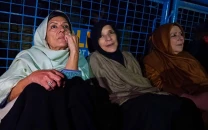The riot of power
The so-called ‘power crisis’ is, in fact, a state of affairs growing out of 3 different areas where government failed.

What we typically call the ‘power crisis’ in Pakistan is not a shortage of electricity. The so-called ‘power crisis’ is, in fact, a state of affairs that grows out of three different areas where the government has failed.
First and foremost, there is a fiscal failure. The inability of the government to raise revenues for its growing expenditure requirements means it is unable to pay for the expensive and imported furnace oil to run its power plants. As a result, much of our power generation capacity sits idle throughout the year. The circular debt that we hear so much about is basically an inability to pay the bills for furnace oil that pile up and are eventually converted into loans for the Pakistan State Oil, racking up more and more debt and interest charges through it all.
The second major failure is the issue regarding the scarcity of fuel. Pakistan’s indigenous reserves of gas are dwindling and no new major findings are on the horizon. As existing reserves continue to decline, the growing shortages of this vital fuel are creating bitter wrangling and feuding among all the stakeholders whose businesses depends on gas. So fertiliser manufacturers are at odds with Punjab’s textile magnates who use natural gas as a fuel for their captive power plants to run their industries and meet their export orders. Both of these players perform a vital role in our economy as fertiliser is a key input for the agriculture sector that sustains our food supply and cotton output and textiles are our largest foreign exchange earner, which makes it very difficult to choose winners and losers between them.
The biggest loser in this wrangling over dwindling gas reserves is our power sector, which relies on gas as a primary fuel. More than two-thirds of our electricity is generated from burning fossil fuels — what industry insiders call ‘thermal power generation’ — and when natural gas is not available, they are forced to rely on imported furnace oil instead.
The third major failure is of governance. Managing shortages is a delicate business, and requires some skill in its execution. If you want to understand how power shortages are being managed by our government, look at how water allocations are handled in the agriculture sector and you will get an almost perfect answer. Canal water is usually taken first by the local landlord, and after all his needs are satisfied, whatever is left is allowed to flow downstream where the smaller farmers are left to fight over it. The further away one’s farm is from the canal headworks, the lesser the likelihood that any water will be left by the time it reaches you.
Something similar happens with the scarce electricity in our distribution system, with one important difference. Unlike water, electricity does not flow according to gravity. Its movement through the transmission and distribution system can be channeled and controlled very precisely. This means that there is little difference between upstream and downstream players because electricity can be sent to its point of consumption much more easily than water can be.
So privileged consumers — those for whom electricity is made abundantly available and often for free — are scattered all over the country and they include government offices, ministerial residences and military installations, offices and housing. One of the saddest statistics I have ever come across was the one that showed the government’s outstanding electricity bills standing around Rs350 billion, which is the exact size of the outstanding payables in the circular debt. Not only does the consumption of this privileged class of consumers result in shortages for everybody else, but the cost of providing them free electricity has to be borne by those who regularly pay their bills i.e., you and me.
Given these three failures — fiscal, fuel and governance — no amount of additional power generation capacity will help in alleviating the power crisis. More than anything else, what Pakistan needs right now is the proper exercise of political power to raise revenue, arrange alternative fuel supplies and bring transparency to the way electricity is allocated within the system. Until then, our streets will continue to burn.
Published in The Express Tribune, April 5th, 2012.













COMMENTS
Comments are moderated and generally will be posted if they are on-topic and not abusive.
For more information, please see our Comments FAQ